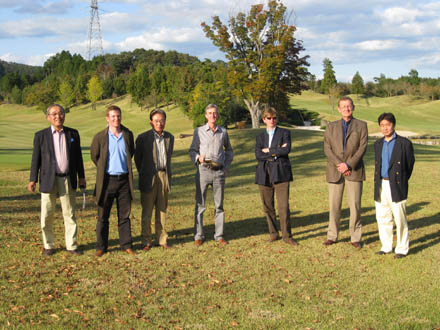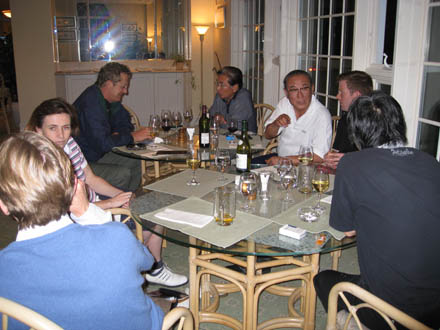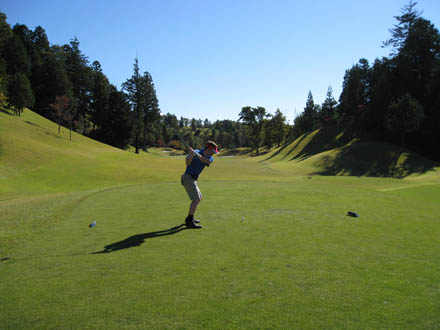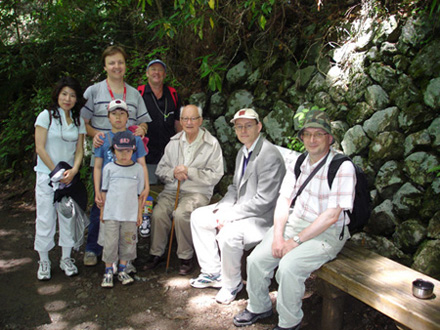No Events upcoming


- 2015-03-28 09:00
- 2014-07-09 05:30
- 2013-09-25 09:00
Guests welcome
Dinner at Tokyo Club, 31st October, 2007
By now our members are no strangers to the handsome clubhouse in Roppongi 1-chome, on the same road as the Swedish Embassy, the American Embassy and the Hotel Okura, and almost in the shadow of the gigantic Ark Hills. On Wednesday 31st October 51 Camford members and guests gathered for dinner. The 6:15 for 7:00 starting time gave the early birds an opportunity to socialize over a glass of wine or two; those of us whose work goes on to a little later may have missed the conversation but were kindly allowed to catch up on the wine.
The Tokyo Club is a private and very exclusive club that only a year or two back began to allow outside parties to use the premises, provided that they were arranged by a member, and on this occasion our ‘host’ Terry Nakamura began the evening by reading us our rights, or more strictly, defining the spaces available for our use. Apart from the usual facilities we had a very nice private dining room, and after dinner, the spacious lobby outside for final drinks. Terry stressed that the Library, which was on the same floor, was out-of-bounds to non-Members, but we had, after all, gone there to eat and drink in good company and no-one seemed tempted to trespass.
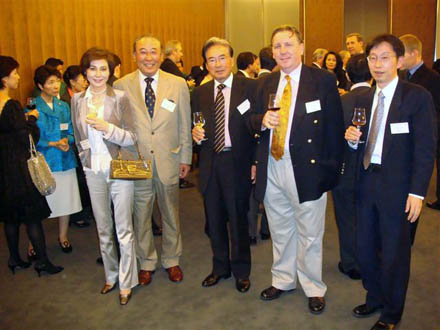
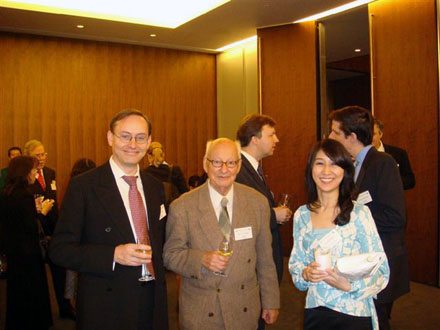
So that we would know what we were eating, Terry had also kindly obtained a translation of the menu, which was all in French. The food, in whatever language, was right up to the usual standard, though before the dessert the waiters seemed a little bemused to carry away so many untouched salads; it appears that many of the British and British-educated still have not taken to the American custom of serving a salad on the side.
Two new members were introduced (Jenny Barb [Clare Cambridge 1978] and Hisao Shiomi [Faculty of Law, Cambridge, 2002]) along with one returnee (Jason James, King’s Cambridge 1983).
Though the Roppongi premises are now the home of the Tokyo Club, its former site in front of the Kasumigaseki Building has gone through yet another transformation. September 26th saw the opening of the new Tokyo Club Building, partly owned by the club, whose immediate impact is as the home of some up-market restaurants.
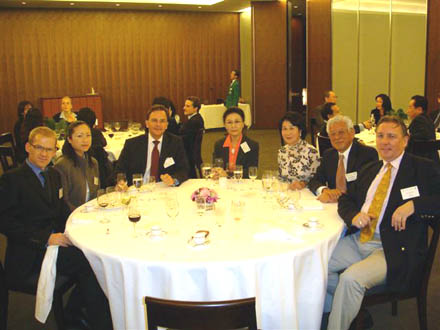
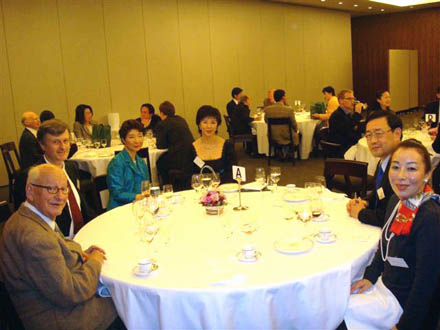
Tim and Huw looking far too serious, and Phil thinking of something to say to the photographer.
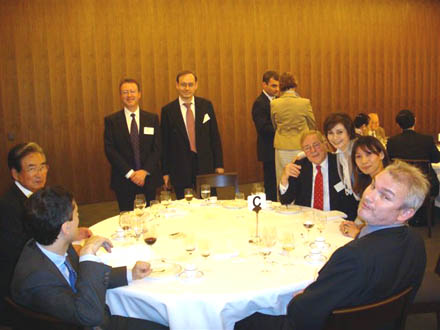
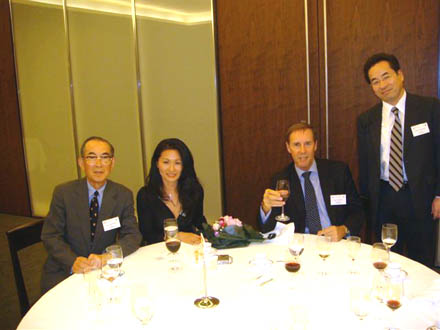
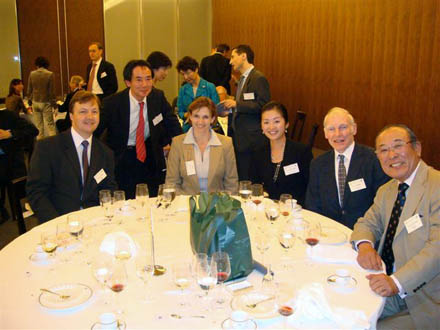
After the dinner at the Tokyo Club, we moved on to a Nijikai at Aux Bacchanale in Ark Hills. We were a little pressed for time with only ten minutes to last orders. But a very pleasant autumn evening with plenty of wine to keep us going.
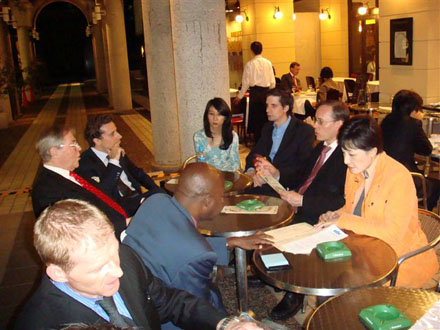
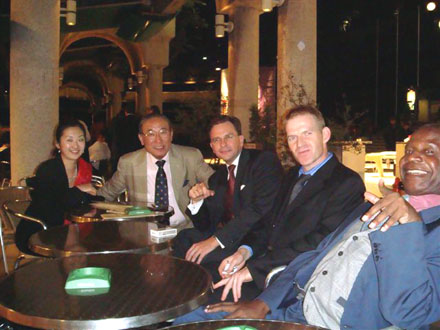
As before we are grateful to Terry Nakamura for arranging for us to have a very pleasant evening. Now that Tim Minton has also become a club member, perhaps we have a back-up.
read more
2007 Autumn Golf Outing to Windsor Park Country Club, Ibaragi October 20-21.
Inspirational round from Oxford Ace, Miller, puts Dark Blues ahead.
The series tied at 15-15, a group of ten assembled at lunchtime on Saturday in near perfect conditions and put in half a round in order to sharpen our games for the tournament on Sunday. An early indication of intent was given by Alex Miller, who drove the green of the par 4 seventh, which clearly unsettled the Cambridge contingent and gave heart to his Oxford team-mates.
However, by midnight it looked like all attempts to sharpen our games had been futile; 12 bottles of wine, dessert wine and a bottle of port later, it seemed unlikely that the quality of golf on Sunday would be of the normal caliber.
Four hours later, the loyal England supporters in our party were watching the Rugby World Cup final (which sadly England lost to South Africa) and were looking doubtful for a 7.30 tee-off.
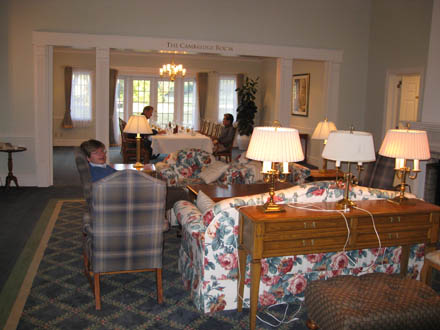
Then at 6.30 History was made; for the first time in its 20 year history, The Windsor Park Country club hosted a party in the Oxford and Cambridge Suite for the Cambridge and Oxford Society, and Champagne flowed.
read more
Odaiba Day
On Saturday 8th September the Society held the "Odaiba Day" events.
The first event was the visit to Oedo Onsen Monogatari, the urban onsen which some members had enjoyed on the occasion of the Society's 100th anniversary celebrations in 2005. This time 7 members and guests gathered to take the plunge and enjoy the somewhat confusing experience of old Edo in the ultra-modern surroundings of Odaiba.
The 7, fully revitalised and refreshed by their bathing, joined another
12 attendees at the Shiokaze no Koen barbecue area quite close to the waterside. As it turned out, the onsen had provided relaxation for muscles and sinews that would soon need to go straight into action assembling tables, chairs and barbecues themselves.
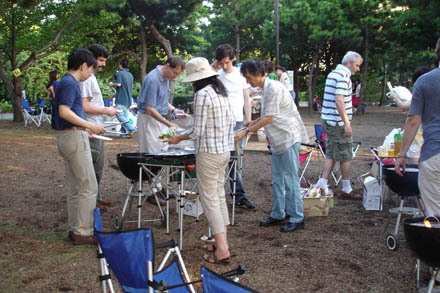
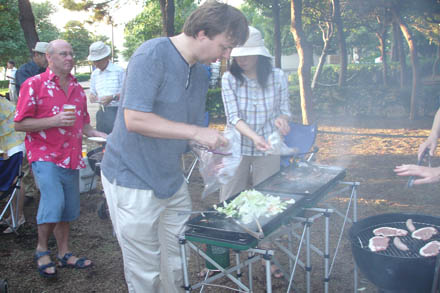
The scene resembled something out of the Krypton Factor or an Army Officer Initiative Course as Cambridge and Oxford graduates of all ages and both sexes struggled to understand exactly how the subtle catches and sliding pieces slotted into place.
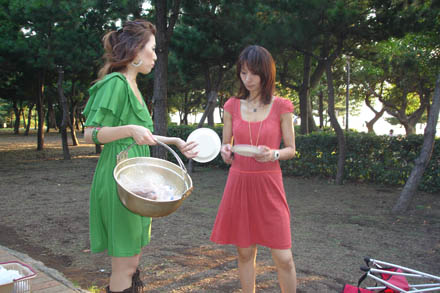
read more
Roppongi Hills Club - cancelled
Roppongi Hills Club party
Unfortunately, it has proved impossible to organise an event at RHC.
Climbing Mt Takao and Dinner at Ukai Toriyama, Saturday, 26th May
Details of the day’s programme will be sent to those who wish to come on the outing.
The following is an outline:
- 12.00: Meet at Takao-sanguchi Station (at the end of the Keio Line)
- 12:15: Climb Mt. Takao (599 m above sea level). Refreshments available at the top.
- 16:40: Take Ukai Toriyama’s private bus from Takao-sanguchi station
- 17:00: Dinner at Ukai Toriyama
(It is, of course, possible to take part in either the hike or the dinner alone.)
Takao-san is one of the closest places to central Tokyo where you can feel that you are finally out of the city. It is not a hard climb, and you certainly do not have to be a seasoned hiker to make it to the top. There are good views of Tokyo and the surrounding mountains on the way up, and a wonderful view of Mt. Fuji (weather permitting) from the top.
The restaurant complex is located in its own gardens in a steep valley about 10 minutes’ drive from Takao-sanguchi Station. It consists of a series of small, traditional Japanese buildings and is the sort of place that Tokyo residents like to take their overseas visitors for a taste of ‘the real Japan’ (the photos on the restaurant’s Japanese-language website, http://www.ukai.co.jp/toriyama/, will give you an idea of the atmosphere). The main feature of the meal is chicken, which is barbecued at the table. There are other choices for anyone who is allergic to chicken.
If you would like to take part in this event, please contact Tim Minton (t.minton[at]camford[dot]org) by 21st May, specifying whether you wish to take part in both the hike and the dinner or just one of them. Please also provide a phone number so that you can be contacted if the weather forces a last-minute cancellation.
Climb up Mt Takao and dinner at Ukai Toriyama
Saturday, 26th May.
The society has organized an annual climb up Takao-san for five years running now. The mountain is close to central Tokyo but feels like the real countryside. The climb in 2006 hit some unpleasant weather, with rain during much of the day. This year however the weather was excellent and the climb very pleasant indeed. We started the climb around 12:30 and made a very leisurely ascent enjoying the scenery and surrounding nature. We chose the route past the waterfall and up the river bank, winding our way around tree roots and descending travellers.
We arrived at the top a little later than normal, having some Soba and beer for lunch. We were joined by Ed Whittaker, who had come separately. We descended in two groups, one taking the chairlift (the cable car was not operating) and the other choosing the road route. We were a little concerned about getting to Takao sanguchi in time to meet the bus, but this proved easier than expected.
We then went off to Ukai Toriyama in two groups and were escorted to a fine room overlooking the pond and waterwheel. The meal of aubergine, grilled chicken and various other delicacies was well received, as were copius quantities of 'bambooo sake'. After the meal we all walked around the gardens taking in the ambience and marvellous vistas, Ukai Toriyama is certainly a truly spectacular place.
We all returned safely to Tokyo after a wonderful day out.
HW, May 2007
Film Preview: "Playing at Politics"
Joint event with The Japan-British Society:
Foreign Correspondents’ Club of Japan
20th Floor, Yurakucho Denki Building (North Building), 1-7-1 Yurakucho, Chiyoda-ku, Tokyo, Tel. 03-3211-3161, Website: www.fccj.or.jp
Thursday, 26th April, 2007 (18:30 – 21:00)
Cost:
Film showing: free
Drinks: consumption basis
Buffet: 2,000 yen
(Payment on the door. No-shows will be billed.)
The book Playing at Politics is about the heated race for the presidency of the prestigious Oxford Union. The author of this book, Dr Fiona Graham, has now made a documentary including behind-the-scenes footage gathered during the original filming. The Oxford Union is a training ground for British politicians and has produced some of the greatest names in British politics. Playing at Politics is currently being shown at film festivals around the world. Dr Graham will be attending the showing on 26th, and a Q&A session is scheduled after the preview.
A buffet dinner will be served between 18:30 and 19:50, and the film screening will begin at 20:00. Tickets for drinks may be purchased at FCCJ’s front desk (please state that you are a member of C&O). Places for the buffet and screening must be reserved in advance, but it is possible to register for just one (presumably the preview!), rather than both. Please call FCCJ’s front desk (and not C&O) on 03-3211-3161 to make reservations. You will be liable for the full buffet charge if you cancel a reservation less than 24 hours in advance.
Information is also attached about a preview of Fiona Graham’s film about the Oxford Union, Playing at Politics, which is to be screened at the Foreign Correspondents’ Club of Japan on 26th April. Applications to attend this event should be addressed directly to FCCJ.
Buffet Dinner at Nambu-tei (南部亭)
Monday, 23rd April, 2007 (18:30 – 21:00)
1-2 Hibiya Park, Chiyoda-ku, Tokyo 100-0012
Tel: 03-3591-1023; website: http://www.nambu-tei.com/
Nambu-tei has proved consistently popular with members. If you have not yet experienced its charms, do take this opportunity to do so.
If you would like to join us, please let Tim Minton know (t.minton[at]camford.org) by 19th April. Members are, of course, welcome to invite guests to this event.
Cost: 7,000 yen inclusive. Payment is required in advance; account details will be sent to those who sign up, as will directions to the restaurant.
No refunds for no-shows or cancellations after the closing date.
Buffet Dinner at Nambutei, Hibiya Park
On Tuesday 23 April, 29 C&O members and guests (30 registrants, less one nefarious no-show) made the now-annual pilgrimage to the delightful Nambutei restaurant on the southern edge of Hibiya Park in central Tokyo.
Of those attending, no fewer than five were new members participating in their very first C&O event, as follows: Dr Yoshie Itani (St Hilda’s, Oxford, 2000~2006), Rev. Kevin Maddy (Selwyn, Cambridge, 1981~84), Dr Etsuo Morishita (Hughes Hall, Cambridge, 1980~82), Max Neuberger (Christ Church, Oxford, 2000~2003) and Sam Vardy (Jesus, Cambridge, 2001~2004).
The restaurant had laid on an excellent buffet dinner featuring a varied menu with a distinct continental theme. The food was accompanied by copious amounts of excellent wine, and the conversation flowed freely as members and guests congregated on the restaurant’s roofed patio.
After half an hour or so of convivial conversation and consumption, Terry Nakamura said a few words and introduced the new members. David Turner then gave the loyal toast, and Julian Culliford pointed out that, as well as being St George’s Day, it was also Shakespeare’s birthday (as well as the day that he died—possibly from a surfeit of birthday cake).
In any event, the food and wine would doubtless have given the Great Bard a new lease of life, and he would certainly have waxed lyrical about our choice of venue for the evening. The charm of this secluded restaurant is that you are liable to totally forget that you are still in the heart of the huge metropolis. The surrounding greenery and gentle ambiance dull the noise and stress of the city, and make for an extremely relaxing and convivial environment.
The evening drifted effortlessly on, as old friendships were renewed and new ones forged, and all too soon our time was nearly up.
There was just time for the cabaret entertainment, starring Alex Williams, before the assembled company said their goodbyes to one another and drifted out of the restaurant and into the warm spring night.
read more
Early Summer Party, The Ambassador’s Residence, British Embassy
Friday, May 11th, 2007 (18:30 – 21:00)
By kind invitation of C&O President and British Ambassador to Japan, Sir Graham Fry, and Lady Toyoko Fry
Footage of the 2007 Oxford and Cambridge Boat Race will be shown at 20:30.
Dress: Lounge suits
Charge: 3,000 yen for one person/5,000 yen per couple (to be paid in advance—account details will be sent to those who register; no-shows will not be refunded.)
As numbers are limited for this event, members are allowed to invite only one guest each; applications will be accepted on a first-come-first-served basis. If you would like to attend, please contact Tim Minton (t[dot]minton[at]Camford[dot]org) by 25th April. Please supply the following information: your name and that of your guest if you wish to bring one; your university/college; your daytime telephone number.
